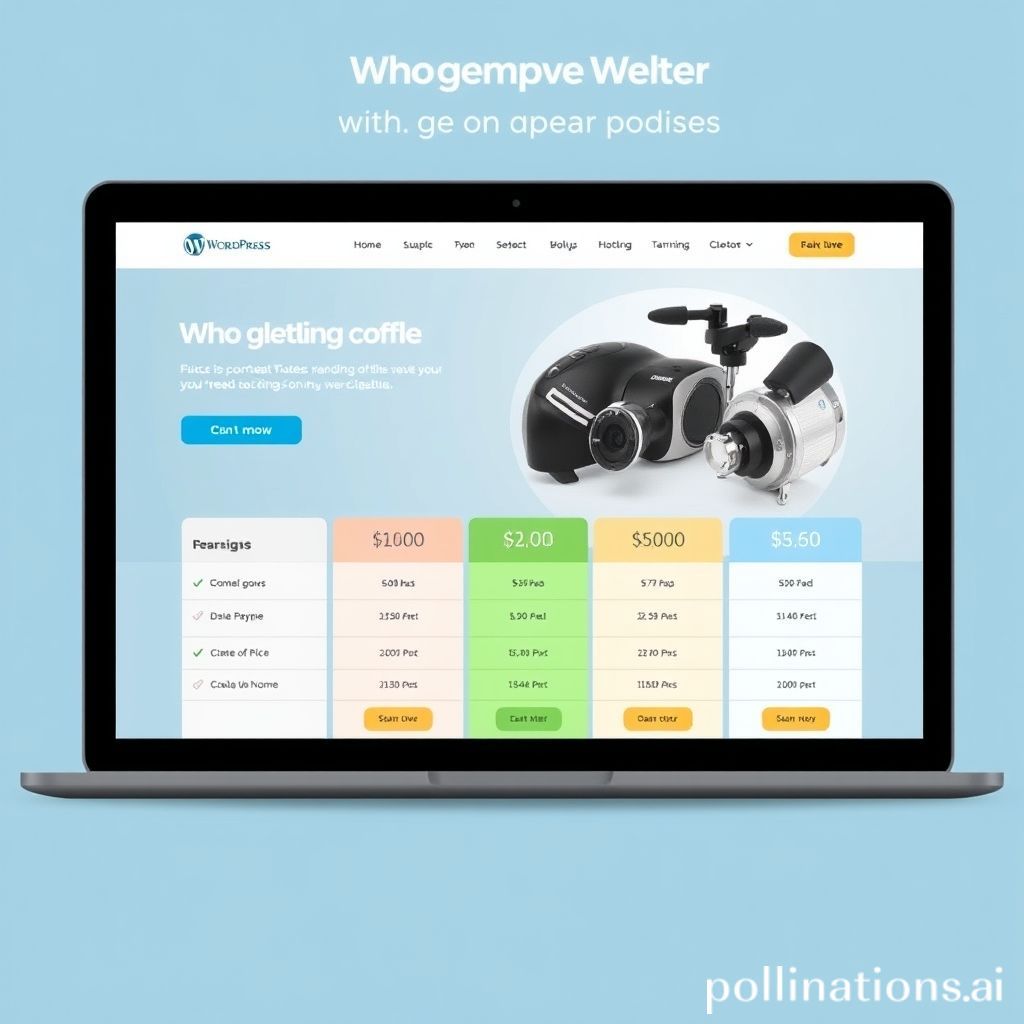Table of Contents
Introduction
In the dynamic world of web design, setting the right price for a WordPress website can be a challenging yet rewarding endeavor. Knowing how to leverage your skills and expertise into a pricing model that accurately reflects your value is crucial not only for your bottom line but also for building lasting relationships with clients.
Embark on a journey with us as we delve into the art of pricing strategy, where creativity meets commerce. Imagine unlocking a newfound potential for your freelance business or design agency by mastering the principles that dictate website pricing.
Whether you are a seasoned professional or a budding enthusiast just starting your journey, understanding how to determine and justify your fees is key. Discover insights into market trends, client expectations, and the value proposition that sets you apart from the competition.

Understanding Your Skill Level and Experience in WordPress Design
Picture this: You’re the captain of your ship, navigating the vast ocean of WordPress design. But hold your horses! Before you set sail, it’s crucial to gauge the depth of your own experience and skills. Are you a greenhorn who’s just discovered the wonders of WordPress, or a seasoned sailor with years of website wizardry under your belt?
Reflect on your journey. Have you tackled a myriad of projects, each one more complex and challenging than the last? Or are you still learning the ropes, figuring out how to turn design dreams into digital reality? This self-reflection isn’t just a pat on the back or a slap on the wrist; it’s the compass guiding your pricing strategy.
Ah, and let’s not forget the stories behind the pixels. Perhaps there’s that one project where a client’s vision seemed as clear as mud, yet you turned it into a masterpiece. These anecdotes are your trump cards, showcasing the unique flair you bring to the table.
In the grand theater of web design, your skill and experience are the stage upon which your pricing performs. Whether you’re charging a king’s ransom or a pauper’s wage, knowing your worth is half the battle. So, how’s your experience shaping up?
Analyzing Market Rates for WordPress Websites and Setting Competitive Prices
Jumping into the world of WordPress design, huh? It’s like diving into a bustling bazaar where prices are as varied as the people. Setting your rates can be as tricky as catching a cat in a rainstorm, but don’t fret! Let’s peel back the layers of this onion.
First things first, consider the market rates—which usually span from a modest hundred bucks for a simple setup to a skyline price of thousands for intricate designs. Freelancers, the lone wolves of this domain, often dance to the tune of $25 to $100 per hour. Meanwhile, agencies boast price tags that make one’s eyes pop, beginning at $75 an hour, soaring upwards depending on complexity, like a hot air balloon with no ceiling.
But here’s the kicker—your pricing shouldn’t just mimic the market’s parrot fashion. Factor in your experience, skills, and the unique flair you bring. Think of what sets you apart as the secret sauce in your pricing recipe. After all, even Picasso didn’t sell his paintings for pocket change.
In this carnival of numbers and creativity, remember to keep your ear to the ground, listen to the market’s whispers, and adjust your sails accordingly. With time, you’ll find the sweet spot that jives with both your buyers—and your wallet!
Factoring in Project Complexity and Client Requirements
When deciding how much to charge for designing a WordPress website, the plot thickens once you consider project complexity and client whims. Picture this: one client wants a simple, no-frills website—a digital business card, if you will. The other? They’re dreaming up a digital masterpiece with a gallery of features that’d make Michelangelo marvel. Ah, the irony, right?
So, here’s the scoop: complexity is like laundry—more layers mean more time. A basic setup might be as breezy as a walk in the park, but a feature-packed site? That’s like scaling a mountain in flip-flops. Transitioning from zero to sixty, there’s also the client’s wishes to weave in. Some folks need e-commerce capabilities, integrated social media, maybe even a splash of animation. Now that’s where the cash register starts ringing like a never-ending symphony.
Remember that story your grandma told, where one size didn’t fit all? That’s precisely what this is. Crafting a price is like painting a picture where every client’s requirements add a splash of their favorite hue. So, consider each project’s complexities and, like a tailor fitting a bespoke suit, adjust accordingly. This balancing act of art and negotiation isn’t for the faint of heart.
Incorporating AI-powered Tools for Content and Design Efficiency
In today’s digital age, the hustle and bustle of website design can be quite the roller coaster. With the rise of AI-powered tools, though, things are starting to look a lot sunnier for designers. You see, these fancy tools are like having a little magic wand in your toolbox, cutting down the time it takes to craft content and layouts as smoothly as a hot knife through butter. Imagine a night owl tirelessly working away, and just like that, an AI buddy steps in, working tirelessly alongside them. It’s almost poetic, isn’t it?
Take, for instance, an anecdote of Alex, a web whiz who once spent countless moonlit hours designing WordPress sites, fueled by a bottomless cup of coffee and pure grit. Now, with AI tools in play, Alex spends more time on creativity and less on repetitive tasks. Efficiency, speed, and innovation are no longer just dreamland thoughts; they are the reality for those who incorporate these tools. The cherry on top? The finished product often feels like a breath of fresh air, dazzling clients and audience alike. So, if you ever feel like you’re chasing your tail, maybe it’s time to embrace these AI wonders, turning the mundane into the spectacular.
Charging for Content Creation and Integration Using AI Content Generators
Setting a price for content creation and integration with AI content generators can feel like a tightrope walk, can’t it? Imagine you’re a painter, but instead of a canvas, you’ve got a digital landscape to fill. The pens in your pocket? AI tools that can whip up words faster than a cheetah chasing lunch. Sure, they’re handy, but remember, they’re just brushes in a grand masterpiece, and the artist’s heart—that’s you!—makes the art. Here’s the kicker: balancing the art and the tool can sprinkle some magic into your work.
So, how do you put a price tag on it? While there’s no one-size-fits-all number, a dash of research goes a long way. Scour the digital seas for what others in your realm are charging. Are they fishing for dollars or reeling in big bucks? Keep a keen eye on the time you invest too. It’s like grandma always said when baking her famous apple pie—watch the clock, and don’t skip the secret ingredient: a sprinkle of creativity. Toss all that into a pot, simmer slowly, and there you have it—a recipe fit for pricing your creative concoctions.
Estimating the Costs of Additional Features and Plugins
Ah, the delightful world of WordPress! It’s a bit like a bustling market where each plugin isn’t just an item, but a story waiting to unfold. Now, when you’re figuring out how much to charge, remember, it’s not just about the nuts and bolts—it’s about weaving a tapestry of wonder. Consider features and plugins as the secret spices in a complex recipe.
Imagine you’re adding e-commerce capabilities; you’re not just setting up a store, you’re building a bustling bazaar—all the bells and whistles included. Each feature, like a currency converter or a stock ticker, adds layers to the cost like vines on an old mansion. Oh, and those plugins that seem to purr seamlessly in the background? They can be like cats—sometimes aloof and demanding attention when least expected.
Think of estimating costs as a dance—sometimes a graceful waltz, other times, a wild tango. You could even stray upon uncharted lands, where new plugins emerge from whispers of code and whispers of ambition, ready to surprise both you and the budget. Navigating this requires a keen sense and a touch of whimsy. Adding in all these factors will help you conjure a price that’s not only fair but a gateway to a masterpiece.
Considering the Time Required for Automated Workflows and Maintenance
When planning out the pricing for designing a WordPress site, don’t overlook the silent soldiers: automated workflows and maintenance. Imagine having a garden where sprinklers water the blooms while you sip lemonade. That’s what automation does for your website. Setting up these workflows might feel like wrestling with an octopus at first, but once in place, they save time, prevent headaches, and ensure everything’s running smoother than a jazz musician’s melody.
Time is a crucial factor here. Picture this: You’ve built a magnificent digital kingdom, filled with sparkling banners and inviting buttons. But alas, without regular maintenance, it might turn into a ghost town. Ensuring that plugins are updated, backups are humming in the background, and the site’s speed is as brisk as a morning jog is no small feat. Keeping an eye on these tasks requires dedication, like a shepherd watching over his flock.
So, when you’re calculating how much to charge, think about these processes as the quiet yet diligent elves behind the scenes. Their continuous upkeep is symbolized by the gentle tick-tock of a clock, whispering of hours saved through automation and peace of mind secured by regular maintenance.
Setting a Rate That Reflects Your Value and Provides Flexibility for Negotiations
Setting a rate for designing a WordPress website is a bit like baking a cake—everyone’s got their own secret recipe, but it all boils down to the right mix of ingredients. You want to cook up something that not only covers your costs but also reflects your skills and lets you wiggle when negotiations get tight. It’s not uncommon for folks to get all tied up in knots figuring out what to charge. But, hey, don’t let this scare you; remember, Rome wasn’t built in a day! Start by tallying up the hours you expect to put into a project, including time for the inevitable curveballs tossed your way. Next, sprinkle in your expertise—those special touches only you can offer. Don’t underestimate your quirks and innovations; they’re worth their weight in gold. When it comes to setting a price, think of it as a dance. Lead confidently, but be ready to pivot if a client wants to cha-cha instead of tango. By weaving in flexibility, you’re not just a designer—you’re a strategic partner, ready to adapt and thrive. So, go on, charge what you’re worth, and let your creative compass guide you.
Conclusion
Unlocking your pricing potential in WordPress design is akin to mastering a fine art, where understanding your expertise, analyzing market rates, and gauging project complexity all play pivotal roles. Yet, in this digital era, leveraging advanced tools like AI-powered solutions is indispensable. Incorporating such tools not only enhances efficiency but also elevates the quality of your work, ensuring you remain competitive in the ever-evolving marketplace.
Ignoring these technological advancements, particularly tools like WPHorde, may leave you trailing behind in the fast-paced web design industry. Embrace innovation and use WPHorde to streamline your design process, deliver superior results, and confidently set prices that reflect your true value.
Visit WPHorde now, revolutionize your design strategy, and secure your spot at the forefront of the WordPress design field. Don’t let this opportunity pass you by—empower your creativity and efficiency with WPHorde today!
Frequently Asked Questions
What factors should I consider when setting my price for a WordPress website?
Consider the complexity of the project, your experience level, the industry standards, and the client’s budget.
Is it better to charge hourly or a flat rate for designing a WordPress website?
It depends on the scope of the project and your preference. Hourly rates can be beneficial for projects with unclear timelines, while flat rates can be more predictable for both you and the client.
How can I find out how much other designers are charging for WordPress websites?
Research industry surveys, forums, and freelance job boards to get an idea of current pricing trends.
What is a reasonable starting price for a basic WordPress website design?
A basic WordPress website design can start anywhere from $500 to $2,000, depending on features and customization.
How do I communicate my pricing to a potential client?
Be transparent about your pricing structure, what it includes, and any additional costs that might come up during the project.





 bit.ly/3D69T88
bit.ly/3D69T88








